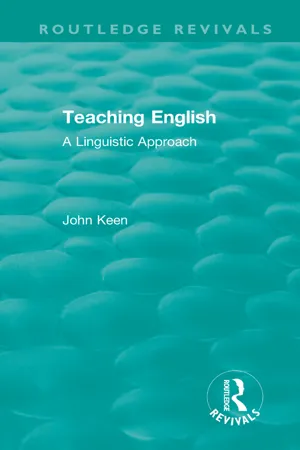
- 130 pages
- English
- ePUB (mobile friendly)
- Available on iOS & Android
About This Book
Published in 1978, this is a concise and practical guide to the use of linguistic theory and analytical techniques in English language teaching at secondary and tertiary levels of education.
Much has been written in this area in the past, but previous emphasis has most often been theoretical. This book is concerned with the realities of teaching, and each technique recommended is explained by reference to actual examples of students' writing and speech. The underlying theory is discussed only when this serves to clarify practice.
John Keen demonstrates how students' existing grasp of the uses and processes of English can provide a reliable base from which to develop their language skills in a meaningful and effective way. His own experience has convinced him that the sympathetic use of linguistic insights can help in teaching the conventions of spelling and grammar, developing students' sensitivity to meaning in language and enabling them to use language resourcefully in a variety of contexts – including writing coherently and at length on particular topics.
The Bullock Report recommended that language study should be part of every teacher's training. This book indicates some directions that such a language study might take.
Frequently asked questions
Information
1 Structures and Functions
Structures
Market Day in Winter
Bad weather never prevents market folk from doing business. It was a cold day and the snow was falling rapidly. Heavey traffic on the road caused the snow on the road to go slushy. Shop roofs were caped with an inch or more of snow. Snow clung to the glass of 5 windows and reminded me of views on christmas cards.People walked quickly round the stalls of the market and only stopping to buy goods and not to look. Children in prams cried because they were cold and getting wetter by the minute. Water from snow flowed off the canvas of the stalls roof to collect in 10 puddles. However the market folk did’nt seem to mind the bad weather. They exhibited their goods with magnificent gestures and had mock arguments to draw attention to themselves.The stalls were packed with every kind of fruits and vegetables on could think off, but the bad weather did nothing to highlight 15 their grandness. Another stall was packed with antiques but trade was slow as bargin hunters were few and far between.The hat and glove stall was doing a tremendous trade, has many shopers did not anticape the wintery weather the afternoon brought.20 At the bus stop dozens of people queued for buses that had been delayed. The queues of people resembled walls, they were all tighly packed together dressed in long overcoats and each holding an umbrella.Building in the distance became faint due to the heavy snow fall 25 and only their outlines could be seen. People walking up the streets resembled dark objects without any real shape.Adults were not amused by the weather but for a short time children playing did received some excitement from the snowball fights, which were going on in the park, adjcent to the market 30 place.
Any non-adjective occurring after ‘the’ or ‘a/an’
Any non-adjective occurring after an adjective
Any word which can occur with -ing
| (1) | N or TN | |
| business (line 1) | their grandness (line 15) | |
| the snow (line 2) | an umbrella (line 23) | |
| (2) | AN or TAN | |
| bad weather (line 1) | a cold day (line 2) | |
| magnificent gestures (line 11) | the bad weather (line 14) | |
| (3) | NN or TNN (The first noun modifies the second). | |
| shop roofs (line 3) | Christmas cards (line 5) | |
| the bus stop (line 20) | the snowball fights ( = T(NN)N) lines 28–9) | |
| (4) | ANPTN | |
| heavey traffic on the road (lines 2–3) | ||
| (5) | TNPN | |
| the glass of windows (lines 4–5) | ||
| (6) | NPNN | |
| views on christmas cards (line 5) | ||
| (7) | TNPTN | |
| the stalls of the market (line 6) | ||
| (8) | N wh- V (V stands for the whole of the complex verb; here ‘had been delayed’). | |
| buses that had been delayed (lines 20–1) | ||
| (9) | T(NN)N wh- VPTNPTNN | |
| the snowball fights which were going on in the park adjcent to the market place (lines 28–30) | ||
| (I am counting ‘adjacent to’ as a preposition, even though it is not a single word, because single-word prepositions can substitute for it. e.g. ‘the park near the market place’). | ||
The NN phrases used in the essay should be listed and used as a core for obtaining a larger set of NN phrases. This may be done by asking the class for words that can fill the gaps created by deleting a word from each of the NN phrases. Thus:
| Fill each blank with a noun: | |
| bus — | — stop |
| bus ... |
Table of contents
- Cover
- Half Title
- Title Page
- Copyright Page
- Original Title Page
- Original Copyright Page
- Table of Contents
- Preface
- Introduction
- 1 Structures and functions
- 2 Understanding your students’ language
- 3 Spelling and grammar: some linguistic implications
- 4 Meanings: a matter of context
- 5 Frameworks for language function
- 6 Cohesion
- 7 Sources
- Further reading
- Bibliographical references
- Index